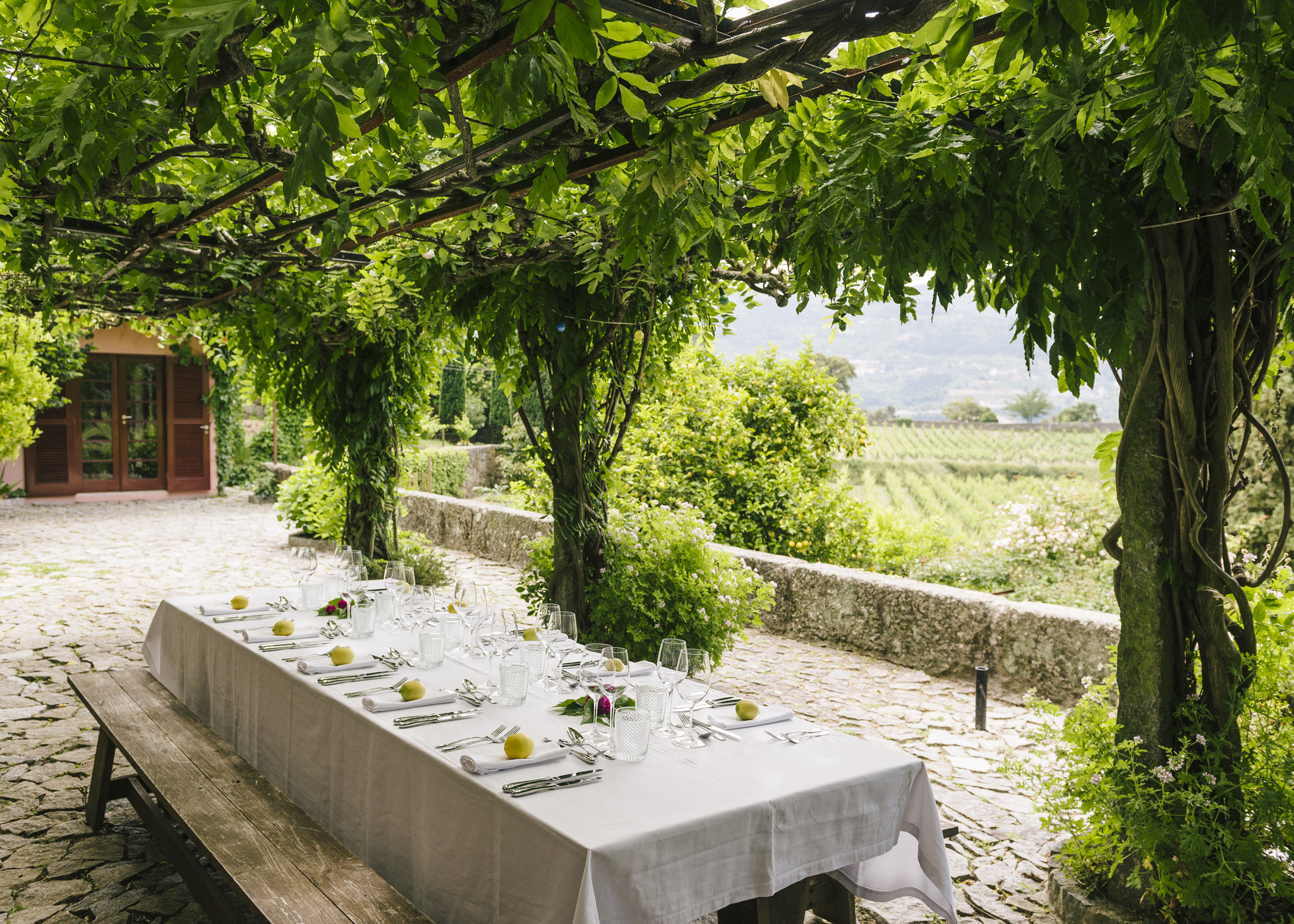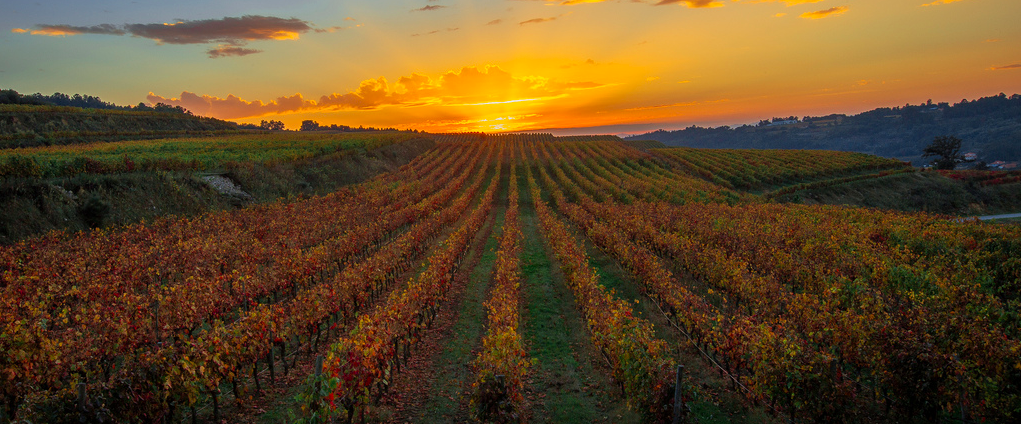
Of all the hidden European gems, Portugal’s Douro Valley is one of our favorites. Beyond its steep terraced vineyards, meandering Douro River, and enchanting sunlight; it also happens to be a breathtakingly beautiful wine region.
Adding to its charm and scenery, the Douro Valley is a historic wine region, having produced wine for over 2,000 years. Demarcated in 1756, the Douro is one of the world’s oldest wine regions, registered as a UNESCO World Heritage Site for its cultural landscape that reflects its technological, social and economic evolution.
For 20 years, we’ve been traveling to the far reaches of the Douro Valley to find exquisite culinary experiences and unique and sustainable Douro wines for our travelers. Now it’s time to share our secrets with you!
Portugal’s famous wine region
There are many reasons to visit the Douro Valley, but its stunning nature is by far one of the biggest. Whether you visit in the Spring when small green buds blanket the region, or in the Autumn as changing leaves of burgundy, crimson and yellow fall heavy with mature grapes, it’s an unforgettable experience.
The Douro’s ‘natural’ aura even extends to the winery, valuing the direct contact from foot-treading of the grapes. What could be more natural than the feel of grapes under foot, and the juice up to your knees in the lagar – an experience we love to provide our travelers!
Like the Champagne region in France, only wine made in the Douro wine region can be officially called Port wine. Port wine is produced in the very same way as any other table wine, with one major exception. After a few days of fermenting, the wine is fortified with aguardiente or wine-based brandy to stop the fermentation process. Vastly diverse and flavorful, there’s a Port wine to taste and savor for every palate.
Where is the Douro Valley?
The Douro Valley is rightly considered a wonder of Nature, nestled in the North of Portugal just above the Douro River. The river extends for 900 kilometers throughout Iberia, as both the Douro and Duero, and carves its way from the Portuguese border to the Atlantic when it reaches Porto.
On its journey, the Douro River has carved a meandering path that is simply mesmerizing from every viewpoint. The contours of the hills and valleys seem to dance in elegant patterns around each other. It may not have the vertiginous drama of other famous fjords or canyons, but the Douro is all the more attractive for the smooth, curved elegance of the picture it has created.
Douro Valley Wineries
The Douro’s ‘natural’ aura even extends to the winery, valuing the direct contact from foot-treading of the grapes. What could be more natural than the feel of grapes underfoot, and the juice up to your knees in the lagar?
There are more than 80 wineries in the Douro Valley. These wine estates are called Quintas and are found along the Douro River between Regua and Pinhão.
If you are taking a road trip to Douro Valley, and spending more than just a day, here are some of our favorite wineries to add to your itinerary.
-
- Quinta Nova – One of the oldest wineries in the Douro Valley.
-
- Quinta do Crasto – Nominated for The Best Vineyard in the World.
-
- Quinta de la Rosa – Voted among the top wineries worldwide.
-
- Quinta das Carvalhas – One of the largest wine-producing estates in the Douro region.
-
- Quinta do Seixo – One of the most recognized wineries in Douro Valley.
-
- Quinta da Popa – Family-run winery known for its organic vineyards.
-
- Quinta da Pacheca – Renowned for its stunning barrel room.
- Quinta da Murcas – Owned by
- Esporao, it’s renowned for its beautiful organic vineyards.
Plan for your Douro wine-tasting tour to last approximately 90 minutes each. To avoid any inconveniences, you can check Catavino to book a worry-free trip to the Douro Valley. Organic and Biodynamic wine lovers may also be interested in our natural and sustainable wine tours.
Douro Valley Experiences
Beyond fully tailored and customized Douro Valley Wine Tours, you can experience walking trails, kayaking, cooking classes and more!
-
- Enjoy a scenic drive along the Estrada Nacional 222
-
- Take a private cruise on a 66-foot-long Wooden Yacht Classic
-
- Savor traditional foods in a private cooking class with a Viscountess
-
- Take the Historical Train, built in 1925, that skirts the Douro river
- Hike along the verdant vines to a private picnic in the vineyards
Douro Valley Local Cuisine
There’s nothing quite like sampling traditional regional cuisine when traveling to new countries, especially when the food is made with local ingredients! To help your gastronomic journey, we have compiled a mouth-watering selection of Douro Valley’s best restaurants. Be sure to check the opening hours before you go:
- Toca da Raposa
- Taberna do Carró
- Calça Curta
- Taberna da Julinha
Best restaurants in Douro Valley near Régua
- Castas e Pratos
Best restaurants in Douro Valley near Pinhão
- Veladouro
- Cozinha da Clara
- Bomfim – Pedro Lemos
How to get to Douro Valley
Whether you travel by car, boat or train to the Douro Valley, you will experience steep, twisting valleys and tidy terraces as far as the eye can see.
Douro Valley By Car
If winding roads and cascading vines appeal to you, then you’ll adore a road trip along the N22, named the World’s Best Driving Road. Along its 27km and 93 winding bends, you’ll encounter rustic ruins, tiny aldeias celebrating Festas Populares (regional festivals), sustainable farms, family-run wineries and plenty of reasons to stop and savor the journey.
Douro Valley By Train
With eleven daily departures to Peso da Régua and five daily services to Pocinho, the Douro train line is a convenient way to travel – especially if curves and bends are not your cup of tea. That being said, it has a few drawbacks.
First, trains in Portugal rarely run on time. Even when they do, your entire trip is dependent on their schedule.
Second, it will be considerably challenging for you to see smaller wineries that are focused on low-intervention and sustainable winemaking practices.
Douro Valley By Boat
Cruise boats regularly leave Porto to various points along the Alto Douro. Though scenic, we rarely suggest this form of travel as it’s both expensive and long. Wait for shorter and more scenic boat cruises from the village of Pinhão in the Douro Valley.
Douro Valley from Porto
There are multiple ways to get to Douro Valley from Porto. By car, take the A4 highway towards Peso de Régua and then the N-222 to Pinhão (1.5 hours).
By train, take the Interregional train that leaves from Porto to Peso de Régua every 2 hours (1 hour 45 minutes).
Douro Valley from Lisbon
By car, take the A1 highway, which takes 3.5 hours from Lisbon to Douro Valley.
There is no direct train route from Lisbon to Douro Valley. You can, however, take a train from Lisbon to Porto and then board a train from Porto to Peso de Régua.
Where to stay in Douro Valley
If you love nature, wine and remote locations, we highly suggest staying for 3-4 days to truly take advantage of the Douro wine region.
If you’re not a wine and nature lover, then a Day Trip from Porto might suit you and your family best.
Our guide on staying in Porto and the Douro Valley can help you decipher whether a Day Trip or a Multi-Day trip targets your needs.
Here, you’ll find our selection of the best Douro Valley hotels.
Best time to visit
The best time of year to visit Douro Valley is Spring, between March and June to experience the valley in full bloom; and Autumn, between September and November to experience the grape harvest.
Though beautiful any time of the year, Spring and Autumn will generally afford you milder temperatures and more opportunities to visit wineries.
Douro Valley Weather
For moderate temperatures and stunning scenery, we suggest visiting the Douro in Spring (late April and the beginning of May) and Fall (mid September to the beginning of November). Why? Because on average, summer temperatures sit around 35ºC (95ºF) to 40ºC (104ºF), which can be uncomfortable if you’re hoping for vineyard walks.
Feature Tours
Douro Valley Premium Wine & Food Tour
On this luxury day tour, you’ll revel in the Douro Valley’s creased and folded mountain slopes,
Douro Valley: Full Day Tour and Tasting
Meet your expert wine guide, Ryan Opaz, in the lobby of your hotel before taking off on a small group
Port Wine Tasting Tour
Your certified wine expert will not only craft the idyllic vinous experience just for you but will personally
Vinho Verde Wine Tour and Tasting
Meet expert wine guide at your Porto Hotel lobby before taking off towards the Melgaço, a stunning northern
Dão & Bairrada Wine Tour
Meet expert wine guide in the lobby of your Porto hotel before taking off on your grand adventure starting
looking for the very best food and wine experiences.
Since 2005, Catavino has been exploring the Iberian Peninsula looking for the very best food and wine experiences.
Feature Stories
Catavino is the best place to learn about travel, food
and wine in Portugal and Spain.







